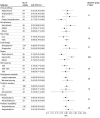Characterization of Risk Prediction Models for Acute Kidney Injury: A Systematic Review and Meta-analysis
- PMID: 37184837
- PMCID: PMC12011341
- DOI: 10.1001/jamanetworkopen.2023.13359
Characterization of Risk Prediction Models for Acute Kidney Injury: A Systematic Review and Meta-analysis
Abstract
Importance: Despite the expansion of published prediction models for acute kidney injury (AKI), there is little evidence of uptake of these models beyond their local derivation nor data on their association with patient outcomes.
Objective: To systematically review published AKI prediction models across all clinical subsettings.
Data sources: MEDLINE via PubMed (January 1946 to April 2021) and Embase (January 1947 to April 2021) were searched using medical subject headings and text words related to AKI and prediction models.
Study selection: All studies that developed a prediction model for AKI, defined as a statistical model with at least 2 predictive variables to estimate future occurrence of AKI, were eligible for inclusion. There was no limitation on study populations or methodological designs.
Data extraction and synthesis: Two authors independently searched the literature, screened the studies, and extracted and analyzed the data following the Preferred Reporting Items for Systematic Review and Meta-analyses guideline. The data were pooled using a random-effects model, with subgroups defined by 4 clinical settings. Between-study heterogeneity was explored using multiple methods, and funnel plot analysis was used to identify publication bias.
Main outcomes and measures: C statistic was used to measure the discrimination of prediction models.
Results: Of the 6955 studies initially identified through literature searching, 150 studies, with 14.4 million participants, met the inclusion criteria. The study characteristics differed widely in design, population, AKI definition, and model performance assessments. The overall pooled C statistic was 0.80 (95% CI, 0.79-0.81), with pooled C statistics in different clinical subsettings ranging from 0.78 (95% CI, 0.75-0.80) to 0.82 (95% CI, 0.78-0.86). Between-study heterogeneity was high overall and in the different clinical settings (eg, contrast medium-associated AKI: I2 = 99.9%; P < .001), and multiple methods did not identify any clear sources. A high proportion of models had a high risk of bias (126 [84.4%]) according to the Prediction Model Risk Of Bias Assessment Tool.
Conclusions and relevance: In this study, the discrimination of the published AKI prediction models was good, reflected by high C statistics; however, the wide variation in the clinical settings, populations, and predictive variables likely drives the highly heterogenous findings that limit clinical utility. Standardized procedures for development and validation of prediction models are urgently needed.
Conflict of interest statement
Figures



References
Publication types
MeSH terms
Substances
LinkOut - more resources
Full Text Sources
Miscellaneous

